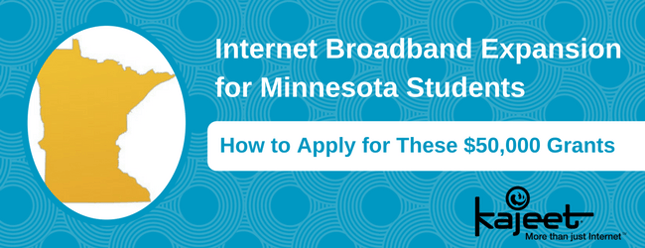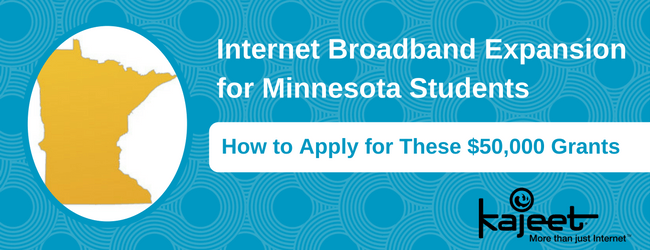
The state of Minnesota is taking a big leap forward to help close the Homework Gap in their state. Paving the way for other states to follow their lead, the North Star State announced a grant intended to fund broadband connectivity to students without Internet outside of school. The legislature appropriated $500,000 to the Department of Education for this one-time appropriation.
We estimate 50,000 kids don’t have Internet access in the state of Minnesota. Kajeet has learned from its client base that a “general rule of thumb” is approximately 15%-25% of students participating in the Free Meal Program (not Free + Reduced) will not have adequate broadband access outside of school.
The Internet Broadband Expansion for Students Opportunity is designed to enable student access to learning materials available on the Internet through filtered mobile broadband connections.
There are two grants to support this effort:
Grant A: Support wireless off-campus learning through a student's use of a data card, USB modem, or other mobile broadband device. The purpose is to enable student access to learning materials available on the Internet through a mobile broadband connection.
Grant B: Use funds to purchase or lease equipment designed to make Internet access available on school buses, including routers and mobile Wi-Fi hot spots to connect to the Internet, and may also purchase or lease one-to-one devices for students. The one-to-one devices may be connected to the Internet through the Wi-Fi hot spot or otherwise contain content for age-appropriate, self-directed learning.
Good news: The Kajeet Education Broadband™ solution meets all the criteria for both grants, including the filters, and falls within the allocated budget.
In order to secure this money, districts will need to include information related to the following:
School districts interested in receiving this award should not waste any time applying as the deadline is Sept. 9 at 3:30 pm. Submissions must be received by that time, and not electronically.
You can find this Minnesota Department of Education grant here. After clicking, search "Access" in the purpose description.
If your district is interested in applying for the one-time appropriation (which is up to $50,000), here are a few things we find might be helpful.
The first step in a successful off-campus Education Broadband program is to determine the number of students who require connectivity, but do not have it at home. This step is critical as it will determine the scope of the program moving forward, including: necessary budget: funding mechanism(s), program management, and expected program impact.
To quickly scope the issue, Kajeet has learned from its client base that a “general rule of thumb” is approximately 15%-25% of students participating in the Free Meal Program (not Free + Reduced) will not have adequate broadband access outside of school.
The more accurate way to determine the need for connectivity is to conduct a formal survey of the students and/or parents. So a few tips:
To assist you, Kajeet has created a sample student connectivity survey based on the best questions from hundreds of our clients. Please feel free to use this survey in whole, in part, or as a starting template for your survey.
Here are a few ways our clients have ensured Kajeet SmartSpots® get into the hands of students who need them the most:
Creating a plan shouldn’t seem like a daunting process. In fact, having a plan in place with goals, objectives, action items, timeline, budget, and ways to measure, ensures buy-in from the administration which can lead to success.
It is likely that your off-campus connectivity strategy is tied to a larger plan, like your district’s technology or mobile learning plan. Begin there.
To help you through this process, Kajeet has put together a reference guide to help you launch your off-campus learning program, as well as provided some helpful hints for applying for the grants needed to fund these programs.


